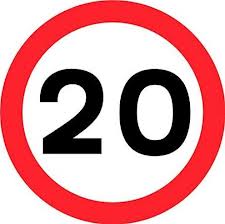New figures show there have been no fatal collisions where Brighton and Hove’s first 20mph zones were introduced since they began in 2013.
 The data, published in a report to today’s environment, transport and sustainability committee, shows all types of collisions and casualties are down in the first zone since it was created in April 2013.
The data, published in a report to today’s environment, transport and sustainability committee, shows all types of collisions and casualties are down in the first zone since it was created in April 2013.
Data for the second phase, introduced last June, is still being analysed, but the report says early indications are that speeds have reduced.
All Collisions in first 20pmh zone by severity
| 18 month average, 2010-2013 | 8/4/2013 to 7/10/2014 | Difference | |
| Fatal | 1.5 | 0 | -1.5 (100%) |
| Serious | 79.5 | 74 | -5.5 (7%) |
| Slight | 393.5 | 322 | -71.5 (18%) |
| Total | 474.5 | 396 | -78.5 (17%) |
All casualties in first 20mph zone
| 18 month average 2010-2013 | 8/4/2013 to 7/10/2014 | Difference | |
| Fatal | 1.5 | 0 | -1.5 (100%) |
| Serious | 80.5 | 74 | -6.5 (8%) |
| Slight | 473 | 398 | -75 (16%) |
| Total | 555 | 472 | -83 (15%) |
As well as updating councillors on the progress of the first two 20mph zones, the report also asks them to approve the next step in the consultation for the third zone – the advertising of speed orders.
The first zone extends from Sackville Road in the west to Freshfield Road in the east and north as far as Old Shoreham Road.
The second covers much of the suburbs, from Portslade in the west to Moulsecoomb and Whitehawk in the east and Patcham in the north.
The proposed third zone extends the 20mph limit to Hangleton, Mile Oak, Ovingdean, Rottingdean, Saltdean, Woodingdean and the Medina Terrace area of Hove.










Oh dear! The Naysayers that have put up so much resistance will not be pleased. The latest wheeze was to tell us that accidents had gone up in the 20mph zones!
What we now need is proper enforcement of the speed limits in the city. I am sure that we will see further big reductions in accidents and incidents if that is done.
@Napoleon – I wonder who encouraged Jo Wadsworth to repeat this information that the greens originally posted last year?
Seems you forgot that these figures were dismissed by the councils own statisticians as being not sufficient to prove anything – but as the results tied in with those from other locations then it would seem plausible.
It could well be that the reductions are from normal variations in data, but that wouldn’t stop those wanting to use it as justification for the success of their failed vanity project – for example – as we all know – very few drivers take any notice of the limits anyway.
Most taxi drivers go at about 45!
Those statistics look totally bogus to me anyways. How can “1.5” people have died in the previous period?? You can’t half a death.
I strongly suspect that if we saw the raw data it would show that the variations are within the bounds of random noise.